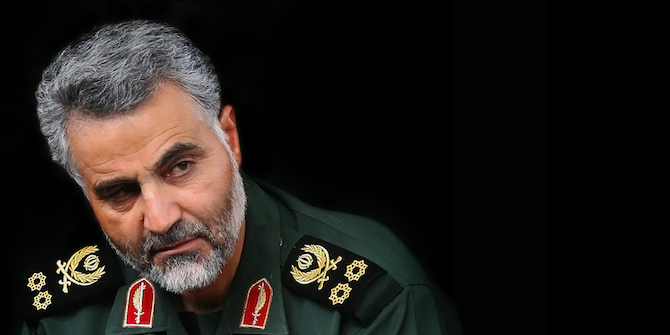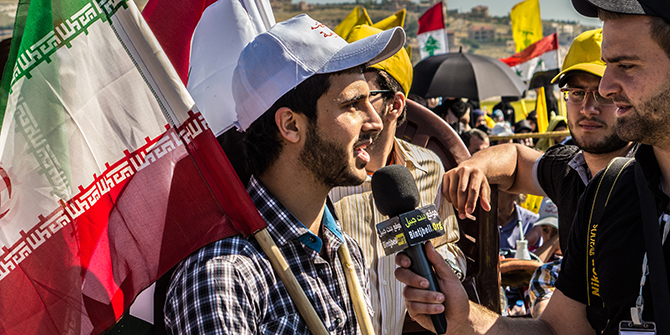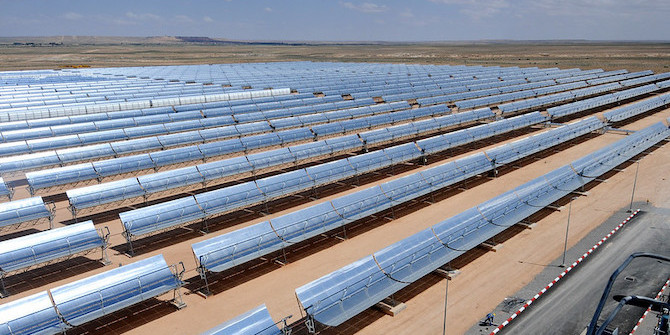by Ali Shihabi
This memo was presented part of a workshop organised by the LSE Middle East Centre looking at the Saudi–Iran rivalry in the region on 7 May 2018.

Since 1979, the Kingdom of Saudi Arabia has seen itself as facing a radical, militaristic and expansionist Iran that leverages Shi’a disenfranchisement, local power vacuums and a vast and growing network of well-armed and well-trained proxies to export its Islamic Revolution throughout the Middle East. From the Saudi perspective, the kingdom is fighting a rearguard action against a transnational theocratic revolution, the destabilising power of which has strengthened following the 2003 Iraq War and subsequent US disengagement with the region.
The Islamic Republic’s animus toward Saudi Arabia is driven by historical, ideological and geopolitical factors. As early as 1943, a young Ayatollah Ruhollah Khomeini published his first political polemic, The Unveiling of Secrets, which sought to discredit Iranian Shi’a reformers by comparing them to ‘the savages of Najd and the camel herders of Riyadh’.
Khomeini’s antagonism toward the kingdom would remain consistent throughout his lifetime. Following Iran-backed Shi’a demonstrators sparked a confrontation against the kingdom’s security forces during the 1987 Hajj, he denounced the ‘vile and ungodly Saudis’ as ‘daggers that have always pierced the hearts of Moslems from the back’. Two years later, Khomeini’s last will and testament, read aloud to Iran’s Assembly of Experts by his handpicked successor, Ayatollah Ali Khamenei, decried the ‘illegitimacy’ of the Saudi ‘puppets’ of the United States who propagate ‘an anti-Qur’anic religion that is this totally baseless and superstitious religion of Wahhabism’.
Khomeini’s viewpoint is firmly embedded in the historical memory of Iran’s clerical class. For theocrats more than for ordinary politicians, historical memory shapes identities and ambitions. And for Iran’s mullahs, Saudi Arabia is the modern manifestation of the same Saudi–Wahhabi forces that, in the early nineteenth century, repeatedly attacked the Shi’a holy cities of Najaf and Karbala, destroying shrines dedicated to imams Ali and Hussein, two of Shiism’s most revered figures, and killing thousands. Consequently, for Iran’s clerical class, the very existence of the modern Saudi state is an affront to the Khomeinist ideal.
Just as religion underpins the ideological foundation of the Islamic Republic, so too have Iran’s clerics long coveted the cradle of Islam, control of which would bolster their own legitimacy as well as the currency of Khomeini’s vision for a transnational Shi’a theocracy. As Iran expert Vali Nasr notes, Khomeini viewed ‘control of the [Saudi] kingdom as an important stepping-stone to his goal of claiming Muslim world leadership for himself and his movement’.
The Iranians have also historically had designs on Bahrain. Although the Shah dropped Iran’s claim to the island following Bahraini independence, Khomeini and his successors have exploited the hopes of some Bahraini and Saudi Shi’a who wish to unite the island kingdom and Saudi’s oil-rich Eastern Province into a single Shi’a-majority polity. As recently as 2007, journalists close to the Supreme Leader were claiming that ‘Bahrain is part of Iran’s soil’ and that ‘the principal demand of the Bahraini people today is to return this province, which was separated from Iran, to its mother, Islamic Iran’. Four years later, Tehran made little secret of its support for Bahrain’s Shi’a insurgency, which sought to overthrow the country’s Sunni rulers.
Saudi anxiety skyrocketed as the 2003 US invasion of Iraq destroyed the one Arab state restraining Iran’s regional ambitions. Five years later, the war-weary American people elected Barack Obama based, in part, on his pledge to shrink US overseas military footprint. The subsequent withdrawal of US forces from Iraq, coupled with the Obama administration’s focus on the Iran nuclear deal, allowed Tehran to accelerate its regional expansion virtually unchecked. President Trump has taken a much harder line against Iran than his predecessor, but nonetheless he has indicated that he will continue winding down US regional commitments, expanding the power vacuum that Iran has already used to strengthen old allies and forge new proxies.
From the early days of the Islamic Republic, Iran has worked assiduously to develop these proxy forces – armed militias indoctrinated in Khomeinism – to expand its influence in the Arab world. One by one, the Saudis watched as these proxy forces captured their neighbours: Hezbollah in Lebanon, the Popular Mobilization Units (PMU) in Iraq, and Iran, Hezbollah, and multinational Shi’a militias in Syria. Following the Iran-backed Houthi rebels’ 2014 capture of Yemen’s capital, Alireza Zakani, a confidante of the Supreme Leader, boasted that ‘three Arab capitals [Beirut, Damascus, and Baghdad] have already fallen into Iran’s hands and belong to the Iranian Islamic Revolution, and Sana’a is the fourth’.
For Riyadh, Iranian penetration into Yemen, a country that former US deputy national security advisor Juan Zarate described as the Arabian Peninsula’s ‘soft underbelly’, was the last straw. Saudi Arabia had already fought the Houthi militias to a stalemate in 2009–10. They were a formidable opponent then; how much stronger would they be equipped with Iranian arms and trained by Hezbollah? The thought of allowing the Lebanese militia, whose capabilities exceed those of most Arab armies and which, as Iran’s most important instrument of regional power projection, moulded both Iraq’s PMUs and Syria’s Shi’a militias into deadly fighting forces, to transform the Houthis into a new Hezbollah on the kingdom’s southern border was intolerable. Saudi Arabia’s leaders decided to act to preempt this outcome.
Critics may downplay Saudi concerns about Iranian expansionism, accusing Riyadh of ‘seeing an Iranian behind every tree’, but the kingdom’s leaders, having watched Iran very carefully, see a country whose economy is in tatters – the Iranian Rial has lost over one-third of its value in the last year alone – and that has suffered thousands of dead and wounded on the battlefields of Syria, Lebanon and Iraq, and yet, despite these mounting costs, continues to direct its dwindling resources away from domestic development and funnel them towards external power projection.
The Iranian people have made the same observations about their government’s priorities. Iran’s ongoing protests, which began at the end of 2017, have been fuelled by its citizens’ demands that Tehran stop funding foreign adventurism and concentrate on meeting its own people’s basic needs. Unfortunately, Iran’s leaders show no signs of bowing to this public pressure. Until they do, Saudi Arabia will continue to see itself as the last brick in the ‘Arab wall’ preventing the Gulf region from falling completely under Iran’s revolutionary suzerainty.
 Ali Shihabi is the Founder of the Arabia Foundation. A Saudi national, he graduated with a BA from Princeton University and an MBA from Harvard Business School. He tweets at @aliShihabi.
Ali Shihabi is the Founder of the Arabia Foundation. A Saudi national, he graduated with a BA from Princeton University and an MBA from Harvard Business School. He tweets at @aliShihabi.
Other posts in this Series:
- Saudi Domestic Uncertainties and the Rivalry with Iran by Madawi Al-Rasheed
- Saudi Arabia and Iran: Mirrored Islamisms by John Jenkins
- Saudi Arabia, Iran and the Struggle for Supremacy in Lebanon and Bahrain by Simon Mabon
- Yemen: Background to the Manufacture of a Proxy War by Helen Lackner
- Saudi–Iranian Rivalry and the Impact on the Syrian Conflict by Julien Barnes-Dacey
- Weathering the Storm: Europe’s Iran Policy after America’s Withdrawal from the Nuclear Deal by Riccardo Alcaro
- Balancing Act: Russia between Iran and Saudi Arabia by Mark N. Katz
- Conceptual Origins of Iranian-Saudi Entanglements by Mahmood Sariolghalam







I’m puzzled why Saudi Arabia should be trembling at the threat of Iran. Whatever that threat might be, it can’t be a military one. Saudia Arabia outspends Iran on military equipment by a factor of five to one, and whereas Saudia Arabia has the latest American equipment, Iran’s military hardware is almost ancient by comparison, much of it dating from the 1970s. I suspect Riyadh’s biggest worry is that Iran will support the democratic struggle of Shia populations in Bahrain and within Saudi Arabia and thereby supposedly “destablise” the region, meaning undermine Saudi authoritarian rule.
the journalists think we donkeys in thought explain why did Saudi use excessive force to unarmed iran pilgrims and who funded Taliban plus al Qaida and that isn’t Saudi expansion as well,why did saddam wage 10 years war using even burn weapons killings almost 1 millions iran civilians